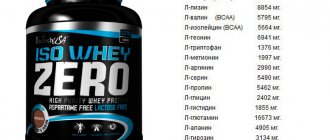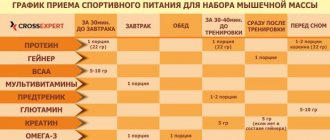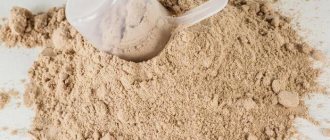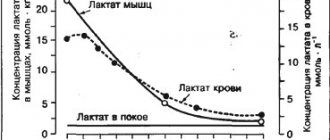One of the two main components of milk, whey, is made from the liquid part of milk that is separated from the curds (the second main component) during the cheese making process. Whey contains proteins, fats, carbohydrates, vitamins and minerals.
Because it is rich in amino acids and easy to digest, whey is perhaps the most popular sports nutritional supplement. Whey protein has been scientifically shown to be essential for accelerating muscle protein synthesis, sustainably burning fat, and strengthening the immune system. Also, whey improves insulin sensitivity and significantly reduces appetite. In addition, whey protein concentrate accelerates the production of glutathione, our bodies' No. 1 antioxidant.
Compound
Eating isolate helps you get your daily protein intake while avoiding excess carbohydrates and fats.
Isolate is a form of milk protein that has been thoroughly purified. It contains over 90% pure protein.
One serving of isolate includes:
- Up to 24 grams of protein;
- Up to 3 grams of carbohydrates;
- Up to 1.5 grams of fat.
The isolate also contains:
- microelements (potassium, calcium, sodium, fluorine, etc.);
- amino acids (arginine, alanine, glycine, leucine, etc.).
The calorie content of a serving of isolate is up to 140 kcal.
Soy protein is produced for people with lactose intolerance and vegetarians.
The soy product contains a similar amount of protein, but is less rich in microelements and amino acids.
Beneficial features
Proteins can be used by both men and women.
When consumed correctly, proteins do not have a negative effect on the body.
The benefits of protein supplements include:
- replenishment of nutrients;
- normalization of the heart and blood vessels;
- helping the body recover faster after physical activity;
- reducing the production of hormones that can destroy muscle tissue;
- regulating the ratio of proteins, fats and carbohydrates in the diet.
When consumed correctly, proteins do not have a negative effect on the body.
Harm to health can occur if they are taken in excess and precautions are not followed.
Operating principle
Proteins are an important building material for the entire human body.
Taking protein supplements replenishes the required amount of proteins and helps the body function normally.
After protein enters the body, it breaks down into amino acids. It is these amino acids that are the substances that form muscle tissue, ligaments or joints.
The development of the body requires a large amount of amino acids in the form of polypeptides. The human body synthesizes some amino acids on its own, but the rest must be obtained from food.
Taking protein supplements replenishes the required amount of proteins and helps the body function normally.
In addition, due to the additional amount of protein consumed, muscle mass increases, which is primarily needed by athletes.
When losing weight, isolate helps to quickly saturate the body and reduce the amount of calories consumed by reducing fats and carbohydrates in the diet.
At the same time, to break down proteins, the body spends a lot of energy, which it takes from fat reserves.
Be sure to read: Which is better and how to take brewer's yeast for weight gain, what is useful for women and men
Description
Whey protein is a natural protein found in whey (a byproduct of dairy production). When making cottage cheese, the fatty parts are curdled and the remaining liquid part is used as a by-product. To produce protein, whey is dried. The supplement is sold in sports and health food stores as a concentrated and quickly digestible source of protein. Most often, whey protein is purchased by people who want to lose weight, as well as vegetarians and fitness enthusiasts. Taking the supplement has virtually no contraindications. The powder can be taken by people who believe that they do not have enough protein in their diet.
Regimen and dosage regimen
When consuming protein isolate, you should follow a certain regimen and dosage.
Depending on the purpose of use, the rules of administration will vary:
- To build muscle mass, isolate is taken at 2-4 grams per 1 kilogram of weight. For heavy loads, this amount can be increased to 8 grams. It is better to divide the total amount of proteins into several doses during the day. Suitable time for use is in the morning, between meals, 1.5 hours before training and after exercise.
- To lose excess weight, it is enough to take 1-2 grams of isolate per 1 kilogram of weight. The total amount of proteins can be divided into two doses - in the morning and after active physical exercise.
Isolate helps you get the right amount of protein.
When losing weight, isolate helps to quickly saturate the body and reduce the amount of calories consumed by reducing fats and carbohydrates in the diet.
But you shouldn’t replace your entire daily protein intake with it. It is important to get at least half of your daily requirement from food.
This applies to athletes who are gaining muscle mass and want to lose excess weight.
Both forms provide equal benefits
Many studies support the positive effects of whey protein intake in physically active people ().
One study of 192 people found that taking whey protein, including whey isolate or concentrate, led to improvements in lean muscle mass and strength ().
However, despite minor differences in nutrient content, there is no conclusive evidence that whey protein isolate and whey protein concentrate have different effects in your body.
When it comes to protein, one of the most important factors is your total daily intake. Moreover, it is often recommended that most protein come from high-quality sources such as dairy products, eggs and poultry ().
Both whey isolate and concentrate are high quality proteins, and it is reasonable to expect that they will produce similar effects if an equivalent dose of protein is taken ().
With that said, those who are limiting their intake of fat, carbohydrates, or lactose may prefer whey isolate since it contains lower amounts of all three of these components.
It's also worth noting that many supplements contain a protein blend that includes both whey isolate and concentrate.
Summary:
Although research supports the beneficial effects of whey protein for physically active people, there is no clear evidence of differences in the effects of whey protein isolate and whey protein concentrate.
Rating of the best brands
Many companies are engaged in the production and sale of sports supplements. It's easy to get confused in such diversity.
To purchase high-quality protein and not waste money, you need to focus on time-tested brands of supplements. It is worth choosing products that have been sold for many years and have positive reviews from athletes.
Dymatize Nutrition ISO 100
Dymatize Nutrition ISO 100
This isolate is one of the most popular among athletes and those losing weight. It contains only protein and no carbohydrates. A serving of the supplement provides 28 grams of pure protein and only 106 kcal.
Numerous reviews contain positive ratings and evidence of the effectiveness of the product. An additional advantage is the absence of an unpleasant aftertaste.
Lactalis Prolacta 95
This is a protein from a French manufacturer.
It is a highly purified product and is used for the production of sports and baby food. The isolate contains 95% protein and 1% carbohydrates.
This isolate is made from whole milk, not whey.
Due to this, high nutritional value is maintained. Thanks to special cleaning, the risk of an allergic reaction is reduced. It can be consumed by people with lactose intolerance.
Syntrax Nectar
This isolate is loved by many customers for its variety of flavors.
At the same time, its tastes are pleasant and do not give off excessive chemicals or a metallic aftertaste. Each serving of the supplement contains 24 grams of protein and a minimum of fat and carbohydrates.
Many reviews indicate strong foaming and poor solubility as disadvantages. But these two characteristics are signs of the quality of a good protein.
Be sure to read: Creatine monohydrate: what is it for, how to take it during cutting and for gaining muscle mass
Platinum Hydrowhey from Optimum Nutrition
Platinum Hydrowhey by Optimum Nutrition
This is a popular brand of sports supplements. You can find many positive reviews about this isolate; it is sold in all sports nutrition stores.
It contains a mixture of isolate and concentrate, and the amount of fat and carbohydrates is reduced to a minimum. The line of flavors is represented by 22 variants of different combinations, as well as 3 natural additives without sweeteners.
Among the advantages, consumers note good solubility without lumps, even in a regular bottle.
Zero Carb by VPX
In the production of this isolate, cross-flow filtration is used, which ensures a high quality product without a single gram of fats and carbohydrates.
The powder contains 20 grams of protein per serving. Several flavor options help diversify your diet.
Whey protein is a high-quality dietary source of protein, so it is not surprising that it is very popular as a protein supplement. People often ask what the differences are between the different whey protein powders on the supplement market and which one is the “best.” There are different types of whey protein: concentrates, isolates, microfiltered isolates, ion exchange isolates and hydrolysates. So let's deal with them once and for all. Introduction
Whey protein is one of the two main milk proteins (the other being casein). The production of this protein involves separating the whey from the milk and then it goes through a processing process (such as ultrafiltration, microfiltration, ion exchange and reverse osmosis) resulting in various whey protein products.
Whey protein products available in the dietary supplement market today include concentrates, low lactose whey protein, isolates, and hydrolysates. Each whey protein product differs in the amount of protein, carbohydrates (lactose), fats, minerals and specific bioactive proteins such as alpha-lactoglobulin, beta-lactoglobulin, immunoglobulins, glycomacropeptides, bovine serum albumin, lactoferrin and lactoperoxidase.
Positive effects
A detailed review of all the positive effects of whey protein in comparison with other proteins such as casein, egg and soy proteins is a topic for another article. And here I will only briefly describe some of its useful properties.
Whey protein is a rich source of highly bioavailable essential amino acids (especially leucine). Incidentally, whey protein has been recognized as an ideal source of protein based on its excellent amino acid profile and high digestibility. In addition, this protein has several additional interesting effects that are of particular value to athletes and physically active people.
In one study, researchers compared two diets that included either whey or casein protein and the same amount of carbohydrates. The results found that, unlike casein, whey protein increased glycogen stores in the muscles and liver. In addition, whey protein is a rich source of the sulfur-containing amino acid cysteine. This fact is noteworthy because cysteine is the key rate-limiting amino acid for glutathione synthesis, and dietary cysteine is considered the rate-limiting substrate for this synthesis. Glutathione is a powerful antioxidant that is also essential for lymphocyte proliferation and immune function. Without going into too much detail, there is evidence that increased glutathione levels (via changes in what is called redox state) can alter gene expression in the direction of muscle growth. In fact, it has been found that the consumption of whey protein concentrate causes an increase in tissue glutathione levels, and that the immune-stimulating effect of this protein can mainly be attributed to its ability to increase glutathione levels.
In another very interesting study, researchers looked at the effects of consuming 20 grams per day of whey protein concentrate for three months. The results found that consumption of whey protein concentrate significantly increased lymphocyte glutathione levels by 35%, as well as increased peak power and 30-second maximal work capacity. In addition, subjects consuming whey protein concentrate experienced a decrease in subcutaneous fat while maintaining body weight! These results definitely have value for athletes and physically active people who are looking to improve their health and get in shape.
Whey Protein Concentrates vs. Isolates
Whey protein isolate has a high protein concentration (90-95%) and contains very little (if any) fat, lactose and minerals. The protein content of whey protein concentrate can vary between 25-89%. However, most of these concentrates contain 80% protein. They also contain some lactose, fats and minerals. The other major difference between whey protein isolates and whey protein concentrates is that isolates contain virtually no lactose and are much more expensive.
Microfiltered Whey Protein Isolates
There are several different microfiltration methods. All of them are used to enrich (or concentrate) various subfractions of whey protein.
Popular microfiltration technologies include Cross Flow Microfiltration (CFM®), Ultrafiltration (UF), Reverse Osmosis (RO), Dynamic Membrane Filtration (DMF), Ion Exchange Chromatography (IEC), Electroultrafiltration (EU), Radial Flow Chromatography (RFC), and Nanofiltration ( NF).
Microfiltration technologies produce high quality (undenatured) protein powders with very high protein content (>90%). Microfiltered whey protein retains important subfractions and contains only small amounts of fat and lactose, so it is definitely worth its high price.
Hydrolyzed proteins
In addition, there is hydrolyzed whey protein (also called hydrolyzed whey peptides). The word “hydrolyzed” means that through technological processes this protein has been broken down into smaller chains of amino acids called peptides. The hydrolytic process mimics our own digestive actions. Thus, we can say that hydrolyzed protein is pre-digested protein. This protein contains mainly dipeptides and tripeptides and is absorbed faster than free form amino acids and much faster than intact (non-hydrolyzed) proteins.
Whey protein hydrolyzate is preferable to consume in post-workout shakes (and before strength training) because it helps increase blood amino acid concentrations more quickly and enhance insulin response within two to three hours. The simultaneous increase in amino acid and insulin levels in the blood, in turn, promotes muscle protein synthesis and prevents its destruction.
What is particularly interesting is that the consumption of protein hydrolyzate solutions (which also contain 15 grams of glucose) causes a sharp increase in the concentration of insulin in the blood, the level of which becomes two and four times higher than after the consumption of solutions with milk and glucose (15 grams of glucose dissolved in water ) respectively. This is despite the fact that in the study where these results were obtained, the carbohydrate content of the milk dose used was almost three times higher.
Thus, consuming protein hydrolyzate as a post-workout shake (and before resistance training) creates a powerful response in blood amino acid and insulin levels, eliminating the need to consume large amounts of carbohydrates and unnecessary calories. Another practical benefit is that protein hydrolyzate can be consumed immediately after a workout without causing too much appetite suppression, so you can have another meal after this shake, thereby optimizing the post-workout anabolic window. Also, have you ever encountered that frustrating situation where protein powders clog up your shaker? If yes, then you now have an additional reason to use whey protein powder with hydrolysates because hydrolysates increase the solubility of the product.
Thus, it is clear that hydrolyzed whey protein is the most popular protein shake among athletes.
Conclusion
To summarize: if you are lactose intolerant in general, then choose whey protein isolate. If you can still tolerate small amounts of lactose, then choose whey protein, which is based on concentrate.
Try to find a whey protein powder that contains some hydrolysates. Hydrolysates are indeed much more expensive than concentrates, but they are really worth the money. Hydrolysates not only increase the availability of amino acids and insulin to muscles (and thus maximize muscle protein synthesis and prevent its breakdown), but also improve the solubility of the powder, eliminating clumps in the shaker. Practical and effective! In addition, you get a product that is low in carbohydrates and sugar.
Now you know everything there is to know about whey protein products.
Criterias of choice
Choosing a good protein supplement is difficult. The wide variety of brands and types of products is simply confusing.
Choosing a Good Protein Supplement Is Difficult
When purchasing proteins, you should pay attention to the following points:
- you need to choose supplements with a minimum amount of carbohydrates and fats (no more than 5 grams per serving);
- the protein content should be maximum (at least 20 grams per serving);
- avoid the presence of additional amino acids;
- check for artificial sweeteners and flavors;
- give preference to companies that have been operating for a long time and have positive reviews.
Harm and side effects
Taking protein supplements helps improve body condition and increase muscle mass. But their uncontrolled use can have side effects and even harm health.
Taking protein supplements helps improve body condition and increase muscle mass
Supplements cannot completely replace all meals.
If overused, the following complications may occur:
- Impaired kidney and liver function. An athlete needs about 2 grams of protein per 1 kilogram of weight per day. When consuming a large amount of isolate, this norm is exceeded. As a result, the load on the excretory system and disruption of the kidneys and liver increases.
- Lack of nutrients. Although proteins are rich in minerals and amino acids, they cannot fully provide the body with all the necessary substances. As a result, a deficiency of substances occurs and disruption of the functioning of the entire body.
- Toxin poisoning. Some additives contain traces of hazardous substances (mercury, lead, cadmium, etc.). Their volume is very small and with moderate protein consumption they do not have a negative effect on the body. But if they are consumed excessively, poisoning occurs.
Compliance with dosages and rules for taking isolate helps to avoid such complications.
Drug interactions
Taking protein supplements and medications at the same time does not cause serious consequences. But due to excess calcium content, the isolate reduces the rate of absorption of certain groups of drugs.
Be sure to read: Post-workout nutrition to gain muscle mass: basic rules, 10 best foods
It is not recommended to use protein isolate and the following medications at the same time:
- Medicines used to treat Parkinson's disease (Levodopa).
- Bone resorption inhibitors (alendronate).
- Antibiotics based on fluoroquinolone and tetracycline (enoxacin, ciprofloxacin, minocycline, etc.).
To minimize the effect of the isolate on drug absorption, it is recommended to take it 2 hours before or 4 hours after taking medications.
Protein selection based on desired results
If you can't decide which type of whey protein is best for you, look at the table and choose it based on the goal you want to achieve.
| Target | Whey Concentrate (WPC) | Whey Isolate (WPI) | Hydrolyzed whey protein (WPH) |
| Gain muscle mass | * | * | |
| Get rid of fat | * | ||
| Lactose intolerance | * | * | |
| Quickly absorbed | * |
How is whey protein made?
The simultaneous use of protein supplements and medications does not cause serious consequences.
Protein isolate is produced on the basis of whey. When enzymes are added to fresh milk for processing into fermented milk products, whey is released.
It is rich in large amounts of protein, minerals and amino acids.
Subsequently, the whey goes through several stages of purification, as a result of which fats, carbohydrates and impurities are removed from it.
The more stages of purification a material goes through during the production process, the higher the quality of the final product. After cleaning, the raw materials are pasteurized and dried to a powder state.
conclusions
Thus, answering the question of how a protein differs from an isolate, several differences can be cited. Firstly, isolate differs from other types of whey protein in a higher degree of purification (when compared with concentrate). Secondly, the isolate is absorbed much faster. And finally, isolate has the best price-quality ratio. That's all the differences between these types of sports nutrition. For mass, athletes can safely take concentrate, but for drying, isolate is best suited.
What is the difference between whey protein isolate and whey protein concentrate?
Based on the quality of whey purification, the following types of additives are distinguished:
- concentrate - a cheap type of supplement with a protein content of 55-84%;
- isolate - this type undergoes thorough purification, as a result of which excess carbohydrates and fats are removed, and the percentage of protein reaches 95%;
- hydrolyzate - this type is considered the most expensive, because it contains up to 100% protein and is quickly absorbed.
The difference between isolate and concentrate is that the former contains more protein and is free of fat and carbohydrates. The second type of protein supplement contains less protein and many unnecessary impurities.
Comparison and which is better
So, whey protein (concentrate) contains more useful substances, but acts slowly, and isolate is a pure protein and begins to be absorbed immediately after consumption. But the difference between the two nutritional supplements does not stop there.
| Characteristic | Whey Protein | Isolate |
| Protein content | 30-80% | 90-99% |
| Additional nutrients | Immunoglobulins, lactoferrin, α-lactalbumin, β-lactoglobulin and much more | Trace amounts |
| Carbohydrate content | Up to 30-50%, in the form of lactose | Trace amounts |
| Effect | Anabolic, catabolism inhibitor, immune stimulant, improves insulin resistance | Anabolic, catabolism inhibitor |
| Metabolism | Relatively slow (starts 1-2 hours after administration) | Relatively fast (starts 10-20 minutes after administration) |
| Price | Relatively low | Relatively high |
Overall the concentrate is better. It contains additional beneficial substances and has a positive effect on the body. And it's also inexpensive. However, it metabolizes slowly and is therefore not suitable for use after training.
The isolate metabolizes quickly, but it is a pure protein. Therefore, you need to saturate your body with additional nutrients.
And if you don’t mind the money, then you can try isolate obtained by microfiltration methods. It is expensive, but at the same time it contains various compounds important for the body - despite the fact that it metabolizes quickly and consists almost entirely of protein.











